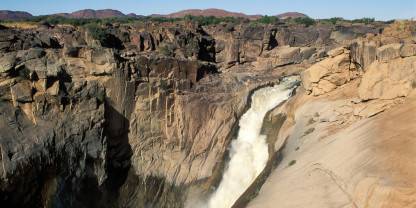Average Expert Rating
Rating Breakdown
Write a User ReviewWaterfalls and arid wilderness
The inhospitable landscape away from the falls means that wildlife is fairly scarce here, but you’ve got a good chance of spotting Oryx, giraffe and other plains game, as well as predators such as bat-eared fox, jackal, and if you’re really lucky, African wild cat.
When I visited this park, a large part of the appeal was the ease with which I could get away from the crowds, but you’ll need a 4x4 as some of the roads are rough. I found myself stopping regularly to just take in the silence and the vast,
Read more
open vistas. Being able to go on bush walks without a guide is always a real treat for me too, but be sure to take lots of water!Rocks and waterfalls
The focus of in this park is, unsurprisingly, the great cataract of Augrabies Falls, where the Orange River – South Africa’s largest – plunges 56m down a gorge on its journey west towards the Atlantic. In full spate during January/February this is a spectacular sight. Otherwise the reserve has a specialised appeal, which may not be everybody’s cup of tea. Its desolate landscape, characterised by domed rock outcrops and statuesque quiver trees, is reminiscent of much of Namibia. Wildlife introduced into the broader reserve includes black rhino, giraffe and oryx, but I found as much interest in the smaller stuff – from flat lizards and rock hyrax to lovebirds and black eagle – and enjoyed the rock-hopping agility of the abundant klipspringers. Caracals are often seen on night drives and the river downstream of the falls is reputedly a good spot for cape clawless otter – though the only predator I encountered was black-backed jackal. Otherwise enjoy the unique scenery, the desert flora and the clear night skies.

